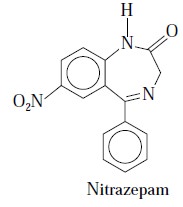Chapter: Pharmaceutical Drug Analysis: Potentiometric Methods
Applications of Potentiometric Titrations in Pharmaceutical Analysis
APPLICATIONS OF POTENTIOMETRIC TITRATIONS IN PHARMACEUTICAL ANALYSIS
Potentiometric titrations have been used extensively for
assay of a number of official compounds. A few typical examples would be
described here, namely : Nitrazepam ; Allopurinol ; and Chloridine
hydrochloride.
A. Assay of Nitrazepam :
Materials Required : Nitrazepam : 0.25 g ; acetic
anhydride : 25.0 ml ; perchloric acid (0.1 M) : 250 ml ; a Potentiometer ; a Magnetic Stirrer ; Burette (50 ml) ;
Theory : Nitrazepam is a weakly basic
compound and hence, it may be titrated conveniently by means of a non-aqueous titration technique and determining the
end-point potentiometrically.

Procedure : Weigh accurately 0.25 g of
nitrazepam and dissolve in 25.0 ml of acetic anhydride. Titrate with 0.1 M perchloric acid placed in a burette and adding
it carefully into the beaker kept on a magnetic stirrer potentiometrically.
Each ml of 0.1 M perchloric acid is equivalent to 28.13 mg of C15H11N3O3.
B. Assay of Allopurinol :
Materials Required : Allopurinol : 0.12 g ;
dimethylformamide : 100.0 ml ; tetrabutylammonium hydroxide (0.1 M) : 1 L ;
Preparation of 0.1 M
Tetrabutylammonium hydroxide (1 Litre) : Dissolve 40 g of tetrabutylammonium iodide in 90 ml of
anhydrous methanol, add 20 g of finely powdered silver oxide and shake
vigorously for 1 hour. Centrifuge a few ml of the mixture and test the
supernatant liquid for iodides. If a positive reaction is obtained add a further
2 g of silver oxide and shake for 30 minutes. Repeat this procedure until the
mixture is free from iodides, filter through a fine sintered-glass filter and
wash the reaction vessel and filter with three 50-ml quantities of toluene. Add
the washings to the filtrate and add sufficient toluene to produce 1000 ml.
Pass dry carbon-dioxide free N2 through the solution for 5 minutes.
Standardization of 0.1 M
Tetrabutylammonium Hydroxide : To 10 ml of dimethylformamide add 0.05 ml of a 0.3 % w/v solution of thymol blue in methanol and
titrate with the tetrabutylammonium hydroxide solution until a pure blue colour
is produced. Immediately add 0.2 g of benzoic acid, stir to effect solution and
titrate with the tetrabutylammonium hydroxide solution until the pure blue
colour is restored. Protect the solution from atmospheric CO2
throughout the titration. The volume of titrant used in the second titration
represents the amount of tetrabutylammonium hydroxide required. Each ml of 0.1
M tetrabutylammonium hydroxide Vs is equivalent to 12.21 mg of C7H6O2.
Procedure : Dissolve 0.12 g of accurately
weighed allopurinol in 50 ml of dimethylformamide, with gentle heating, if necessary. Titrate to the colour change of the
indicator that corresponds to the maximum absolute value of dE/dV in a
potentiometric titration (where E is the electromnotive force and V is the
volume of the titrant). Each ml of 0.1 M tetrabutylammonium hydroxide Vs is
equivalent to 13.61 mg of C5H4N4O.
C. Clonidine Hydrochloride :
Materials Required : Clonidine hydrochloride : 0.2
g ; ethanol (96%) : 100 ml ; 0.1 M ethanolic sodium hydroxide Vs : 1 L (Add 3.3
g of 10 M sodium hydroxide solution to 250 ml of absolute ethanol).
Standardization of 0.1 M
Ethanolic Sodium Hydroxide Solution Vs : Dissolve 0.2 g of benzoic acid in a mixture of 10 ml of ethanol
(96%) and 2 ml of water and titrate with the ethanolic sodium hydroxide
solution using 0.2 ml of thymolphthalein solution (a 0.1 % w/v solution of
thymolphthalein in ethanol (96%) as indicator. Each ml of 0.1 M ethanolic
sodium hydroxide Vs is equivalent to 12.21 mg of C7H6O2.
Procedure : Dissolve 0.2 g of clonidine
hydrochloride in 70 ml of ethanol (96%) and titrate with 0.1M ethanolic sodium hydroxide Vs determining the end-point
potentiometrically. Each ml of 0.1 M ethanolic sodium hydroxide Vs is
equivalent to 26.66 mg of C9H9Cl2,N3,
HCl.
1. COGNATE ASSAYS
A plethora of official drugs are assayed by the
potentiometric method in various official
compendia, and a few selected examples are given in Table 16.3, which may
be assayed potentiometrically :

Related Topics